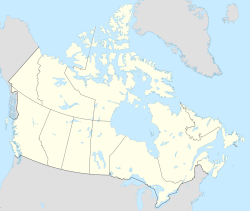Rolling Hills is a hamlet in southern Alberta, Canada within the County of Newell.[2] Rolling Hills was founded in 1939 by the Prairie Farm Rehabilitation Administration (PFRA) with settlers from dried out regions of Saskatchewan and Alberta.
Rolling Hills | |
|---|---|
 | |
| Coordinates: 50°13′32″N 111°46′28″W / 50.22556°N 111.77444°W | |
| Country | Canada |
| Province | Alberta |
| Region | Southern Alberta |
| Census division | 2 |
| Municipal district | County of Newell |
| Government | |
| • Type | Unincorporated |
| • Governing body | County of Newell Council |
| Area (2021)[1] | |
| • Land | 0.69 km2 (0.27 sq mi) |
| Population (2021)[1] | |
• Total | 273 |
| • Density | 397.6/km2 (1,030/sq mi) |
| Time zone | UTC−07:00 (MST) |
| • Summer (DST) | UTC−06:00 (MDT) |
| Area code(s) | 403, 587, 825 |
Demographics
edit| Year | Pop. | ±% |
|---|---|---|
| 1941 | 62 | — |
| 1951 | 142 | +129.0% |
| 1956 | 134 | −5.6% |
| 1961 | 171 | +27.6% |
| 1966 | 132 | −22.8% |
| 1971 | 127 | −3.8% |
| 1976 | 171 | +34.6% |
| 1981 | 175 | +2.3% |
| 1986 | 176 | +0.6% |
| 1991 | 164 | −6.8% |
| 1991A | 170 | +3.7% |
| 1996 | 178 | +4.7% |
| 2001 | 234 | +31.5% |
| 2006 | 246 | +5.1% |
| 2011 | 205 | −16.7% |
| 2016 | 258 | +25.9% |
| 2021 | 273 | +5.8% |
| Source: Statistics Canada [3][4][5][6][7][8][9][10][11][12][13][14][15][16][1] | ||
In the 2021 Census of Population conducted by Statistics Canada, Rolling Hills had a population of 273 living in 108 of its 113 total private dwellings, a change of 5.8% from its 2016 population of 258. With a land area of 0.69 km2 (0.27 sq mi), it had a population density of 395.7/km2 (1,024.7/sq mi) in 2021.[1]
The population of Rolling Hills according to the 2020 municipal census conducted by the County of Newell is 263.[17]
As a designated place in the 2016 Census of Population conducted by Statistics Canada, Rolling Hills had a population of 258 living in 101 of its 104 total private dwellings, a change of 25.9% from its 2011 population of 205. With a land area of 0.69 km2 (0.27 sq mi), it had a population density of 373.9/km2 (968.4/sq mi) in 2016.[16]
Economy
editRolling Hills’ primary industry is agriculture. Specialty crops grown in the area include dry edible beans, sugar beets, potatoes, seed canola and seed alfalfa. Cattle have always been a major part of the agricultural landscape in the Rolling Hills area.
Education
editOne school, serving pre-kindergarten through grade 9, is located in Rolling Hills. After grade 9, students attend high school in Brooks, which is approximately 50 km (31 mi) northwest of Rolling Hills.[18]
See also
editReferences
edit- ^ a b c d "Population and dwelling counts: Canada and designated places". Statistics Canada. February 9, 2022. Retrieved February 10, 2022.
- ^ "Specialized and Rural Municipalities and Their Communities" (PDF). Alberta Municipal Affairs. June 3, 2024. Retrieved June 14, 2024.
- ^ Ninth Census of Canada, 1951 (PDF). Vol. SP-7 (Population: Unincorporated villages and hamlets). Dominion Bureau of Statistics. March 31, 1954. Retrieved September 22, 2024.
- ^ Census of Canada, 1956 (PDF). Vol. Population of unincorporated villages and settlements. Dominion Bureau of Statistics. October 25, 1957. Retrieved September 23, 2024.
- ^ 1961 Census of Canada: Population (PDF). Series SP: Unincorporated Villages. Vol. Bulletin SP—4. Ottawa: Dominion Bureau of Statistics. April 18, 1963. Retrieved September 25, 2024.
- ^ Census of Canada 1966: Population (PDF). Special Bulletin: Unincorporated Places. Vol. Bulletin S–3. Ottawa: Dominion Bureau of Statistics. 1968. Retrieved September 25, 2024.
- ^ 1971 Census of Canada: Population (PDF). Special Bulletin: Unincorporated Settlements. Vol. Bulletin SP—1. Ottawa: Statistics Canada. 1973. Retrieved September 25, 2024.
- ^ "Geographical Identification and Population for Unincorporated Places of 25 persons and over, 1971 and 1976". 1976 Census of Canada (PDF). Supplementary Bulletins: Geographic and Demographic (Population of Unincorporated Places—Canada). Vol. Bulletin 8SG.1. Ottawa: Statistics Canada. 1978. Retrieved September 26, 2024.
- ^ 1981 Census of Canada (PDF). Place name reference list. Vol. Western provinces and the Territories. Ottawa: Statistics Canada. 1983. Retrieved September 26, 2024.
- ^ 1986 Census of Canada (PDF). Population. Vol. Unincorporated Places. Ottawa: Statistics Canada. 1988. Retrieved September 26, 2024.
- ^ 91 Census (PDF). Population and Dwelling Counts. Vol. Unincorporated Places. Ottawa: Statistics Canada. 1993. Retrieved September 26, 2024.
- ^ 96 Census (PDF). A National Overivew: Population and Dwelling Counts. Ottawa: Statistics Canada. 1997. Retrieved September 26, 2024.
- ^ "Population and Dwelling Counts, for Canada, Provinces and Territories, and Census Divisions, 2001 and 1996 Censuses - 100% Data (Alberta)". Statistics Canada. August 15, 2012. Retrieved September 19, 2024.
- ^ "Population and dwelling counts, for Canada, provinces and territories, and designated places, 2006 and 2001 censuses - 100% data (Alberta)". Statistics Canada. July 20, 2021. Retrieved September 19, 2024.
- ^ "Population and dwelling counts, for Canada, provinces and territories, and designated places, 2011 and 2006 censuses (Alberta)". Statistics Canada. February 8, 2012. Retrieved September 19, 2024.
- ^ a b "Population and dwelling counts, for Canada, provinces and territories, and designated places, 2016 and 2011 censuses – 100% data (Alberta)". Statistics Canada. February 8, 2017. Retrieved February 13, 2017.
- ^ "Municipal Census Report 2020". County of Newell. p. 3. Retrieved September 25, 2021.
- ^ "Rolling Hills Agricultural Academy website". Rolling Hills School. Retrieved July 5, 2024.
External links
editMedia related to Rolling Hills, Alberta at Wikimedia Commons

